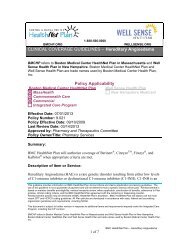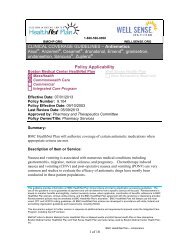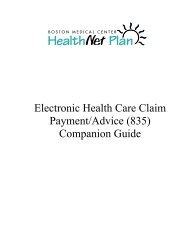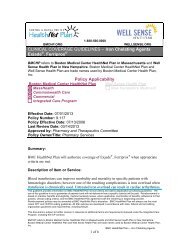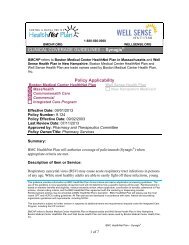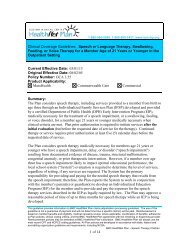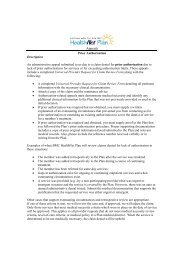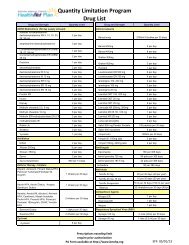Varicose Vein Treatment - BMC HealthNet Plan
Varicose Vein Treatment - BMC HealthNet Plan
Varicose Vein Treatment - BMC HealthNet Plan
You also want an ePaper? Increase the reach of your titles
YUMPU automatically turns print PDFs into web optimized ePapers that Google loves.
Clinical Background Information and References:<strong>Varicose</strong> veins are superficial dilated, tortuous veins that result from defective functionsof the valves of the saphenous veins, weakness of the vein wall, high intraluminalpressure and rarely from arteriovenous fistulas. <strong>Varicose</strong> veins can be primary orsecondary. Primary varicose veins originate in the superficial system and occur morefrequently in women. Secondary varicose veins result from deep venous insufficiencyand incompetent perforating veins or from deep venous occlusion that cause thedistention of the superficial veins. Risk factors for the development of varicose veinsinclude: Age, sex, obesity, genetics and prolonged standing. Women are more likely thanmen to develop the condition and hormonal changes of pregnancy can be a contributingfactor. Symptoms of varicose veins consist of a dull ache or pressure sensation in the legsafter prolonged standing that is often relieved by elevating the legs. Other symptomsinclude heaviness, mild ankle edema, cramping, pain, burning, throbbing, and the feelingof heaviness and fatigue in the leg. The clinical signs of varicose vein disease includehyperpigmentation, edema, dermatitis, ulceration, skin induration, hemorrhage andthrombophlebitis.The therapeutic approach will depend upon multiple factors that include medical status,lifestyle, source and origin of venous insufficiency, and size of the involved vein. Anappropriate history and physical is essential with special attention to history ofthrombophlebitis, clotting disorders and any underlying disease process. The need forlaboratory data is generally not required, except in cases of hypercoagulability, severevenous symptoms, and disease states, such as intermittent claudication. Testing shouldinclude Doppler evaluation and/or duplex ultrasonography to rule out incompetence ofthe greater or lesser saphenous veins.<strong>Varicose</strong> veins can usually be treated with conservative measures such as analgesics,elevation of the legs, compression stockings, mild exercise and avoidance of prolongedstanding. Surgical treatment ranges from high ligation and stripping of the greatersaphenous and tributaries to sclerotherapy, laser or radiofrequency vein ablation,miniphlebectomy and vein closure devices. The majority of non-saphenous truncalvaricose veins between 4-6mm are treated either by sclerotherapy or stab phlebectomy.Ligation and stripping procedures are generally done for varicosities that are larger than6mm in diameter. Surgical treatment is reserved for individuals who have failedconservative management, are very symptomatic and suffer from superficial veinthrombosis and/or develop skin ulcerations. With any surgical treatment compressiongarments should be used post-operatively for a few weeks with gradual return toactivities as tolerated.ReferencesAlmeida JI, Kaufman J, Göckeritz O, et al. Radiofrequency endovenous ClosureFASTversus laser ablation for the treatment of great saphenous reflux: A multicenter, single-This guideline provides information on <strong>BMC</strong> <strong>HealthNet</strong> <strong>Plan</strong> claims adjudication processing guidelines. The use of thisguideline is not a guarantee of payment and will not determine how a specific claim(s) will be paid. Reimbursement isbased on member benefits and eligibility, medical necessity review, where applicable, coordination of benefits, adherenceto <strong>Plan</strong> policies, clinical coding criteria, and the <strong>BMC</strong> <strong>HealthNet</strong> <strong>Plan</strong> agreement with the rendering or dispensing provider.Reimbursement policies may be amended at <strong>BMC</strong> <strong>HealthNet</strong> <strong>Plan</strong>’s discretion. <strong>BMC</strong> <strong>HealthNet</strong> <strong>Plan</strong> will always use themost recent CPT and HCPCS coding guidelines. All <strong>Plan</strong> policies are developed in accordance with state, federal andaccrediting organization guidelines and requirements, including NCQA.5 of 9<strong>BMC</strong> <strong>HealthNet</strong> <strong>Plan</strong> – <strong>Varicose</strong> <strong>Vein</strong> <strong>Treatment</strong>
linded, randomized study (RECOVERY study). J Vasc Interv Radiol. 2009;20(6):752-759.American Academy of Dermatology (AAD). New Laser <strong>Treatment</strong>s Get a Leg Up onUnsightly <strong>Vein</strong>s. March 21, 2003. Accessed at:http://www.aad.org/public/News/NewsReleases/Press+Release+Archives/Cosmetic+Dermatology+-+Aging/Leg<strong>Vein</strong>s.htmAmerican Academy of Dermatology (AAD). New <strong>Treatment</strong>s for Leg <strong>Vein</strong>s Stand theTest of Time. July 30, 2004. Available at:http://www.aad.org/public/News/NewsReleases/Press+Release+Archives/Skin+Conditions/newtreatments.htmAmerican College of Phlebology (ACP). <strong>Treatment</strong> of Leg <strong>Vein</strong>s. Accessed at:http://www.phlebology.org/index.cfm?sector=pubs&page=publications&b=imAremu MA et al. Prospective randomized controlled trial: conventional versus poweredphlebectomy. J Vasc Surg. 2004 Jan;39(1):88-94Arumugasamy M et al. The Technique of Transilluminated Powered Phlebectomy, anovel, minimally invasive system for varicose vein surgery. Eur J Vasc Endovasc Surg.2002; 23(2):180-182Creton L et al. Prospective randomized study of endovenous radiofrequency obliteration(closure) versus ligation and vein stripping (EVOLVeS): two-year follow-up. Eur J VascEndovasc Surg. 2005 Jan;29(1):67-73De Roos KP, Ambulatory Phlebectomy versus Compression Sclerotherapy: Results of aRandomized Controlled Trial. Dermatol Surg. 2003; 29(3):221-6Hayes Medical Technology Directory. Endoluminal Radiofrequecy Ablation for <strong>Varicose</strong><strong>Vein</strong>s of the Leg. Winifred Hayes, Inc. June 15, 2009, updated June 8, 2010Hayes Medical Technology Directory. Endovenous Laser Therapy for <strong>Varicose</strong> <strong>Vein</strong>sdue to Great Saphenous <strong>Vein</strong> Reflux. Winifred Hayes, Inc. Feb 6, 2009, updated March9, 2010Hayes Medical Technology Directory. Endovenous Laser Therapy for <strong>Varicose</strong> <strong>Vein</strong>sdue to Small Saphenous <strong>Vein</strong> Reflux. Winifred Hayes, Inc. March 17, 2009, updatedMarch 11, 2010This guideline provides information on <strong>BMC</strong> <strong>HealthNet</strong> <strong>Plan</strong> claims adjudication processing guidelines. The use of thisguideline is not a guarantee of payment and will not determine how a specific claim(s) will be paid. Reimbursement isbased on member benefits and eligibility, medical necessity review, where applicable, coordination of benefits, adherenceto <strong>Plan</strong> policies, clinical coding criteria, and the <strong>BMC</strong> <strong>HealthNet</strong> <strong>Plan</strong> agreement with the rendering or dispensing provider.Reimbursement policies may be amended at <strong>BMC</strong> <strong>HealthNet</strong> <strong>Plan</strong>’s discretion. <strong>BMC</strong> <strong>HealthNet</strong> <strong>Plan</strong> will always use themost recent CPT and HCPCS coding guidelines. All <strong>Plan</strong> policies are developed in accordance with state, federal andaccrediting organization guidelines and requirements, including NCQA.6 of 9<strong>BMC</strong> <strong>HealthNet</strong> <strong>Plan</strong> – <strong>Varicose</strong> <strong>Vein</strong> <strong>Treatment</strong>
Hayes Search & Summary. Endovenous Laser Therapy (EVLT) for IncompetentPerforator <strong>Vein</strong>s. Winifred Hayes, Inc. Dec 18, 2008Hayes Medical Technology Directory. Sclerotherapy for Symptomatic <strong>Varicose</strong> <strong>Vein</strong>s.Winifred Hayes, Inc. Dec 7, 2004. Updated Jan 16, 2009Hayes Medical Technology Directory. Transilluminated Powered Phlebectomy forSymptomatic <strong>Varicose</strong> veins. Winifred Hayes, Inc. May 22, 2002. Updated April 5, 2007Hoggan BL, Cameron AL, Maddern GJ. Systematic review of endovenous laser therapyversus surgery for the treatment of saphenous varicose veins. Ann Vasc Surg.2009;23(2):277-287.Leopardi D, Hoggan BL, Fitridge RA, et al. Systematic review of treatments for varicoseveins. Ann Vasc Surg. 2009;23(2):264-276Lurie F et al. Prospective randomized study of endovenous radiofrequency obliteration(closure procedure) versus ligation and stripping in a selected patient population(EVOLVeS Study). J Vasc Surg 2003 Aug;38(2):207-14National Institute for Clinical Excellence (NICE). Interventional Procedure Overview ofRadiofrequency Ablation of <strong>Varicose</strong> <strong>Vein</strong>s (VNUS Closure). Accessed at:http://www.nice.org.ukNational Institute of Clinical Excellence (NICE). Endovenous Laser <strong>Treatment</strong> of theLong Saphenous <strong>Vein</strong>. Accessed at: http://www.nice.org.ukNational Institute of Clinical Excellence (NICE). Interventional Procedures ConsultationDocument: Transilluminated Powered Phlebectomy for <strong>Varicose</strong> <strong>Vein</strong>s. Accessed at:http://www.nice.org.ukPerkowski P et al. Endovenous Laser Ablation of the Saphenous <strong>Vein</strong> for <strong>Treatment</strong> ofVenous Insufficiency and <strong>Varicose</strong> <strong>Vein</strong>s: Early results from a large single-centerexperience. J. Endovasc Ther. 2004; 11(2):132-138Society of Interventional Radiology (IVR) Position Statement. Endovenous Ablation,2004. Accessed at: http://www.sirweb.org/clinical/policy.shtmlvan den Bos R, Arends L, Kockaert M, et al. Endovenous therapies of lower extremityvaricosities: A meta-analysis. J Vasc Surg. 2009;49(1):230-239.This guideline provides information on <strong>BMC</strong> <strong>HealthNet</strong> <strong>Plan</strong> claims adjudication processing guidelines. The use of thisguideline is not a guarantee of payment and will not determine how a specific claim(s) will be paid. Reimbursement isbased on member benefits and eligibility, medical necessity review, where applicable, coordination of benefits, adherenceto <strong>Plan</strong> policies, clinical coding criteria, and the <strong>BMC</strong> <strong>HealthNet</strong> <strong>Plan</strong> agreement with the rendering or dispensing provider.Reimbursement policies may be amended at <strong>BMC</strong> <strong>HealthNet</strong> <strong>Plan</strong>’s discretion. <strong>BMC</strong> <strong>HealthNet</strong> <strong>Plan</strong> will always use themost recent CPT and HCPCS coding guidelines. All <strong>Plan</strong> policies are developed in accordance with state, federal andaccrediting organization guidelines and requirements, including NCQA.7 of 9<strong>BMC</strong> <strong>HealthNet</strong> <strong>Plan</strong> – <strong>Varicose</strong> <strong>Vein</strong> <strong>Treatment</strong>
VNUS Medical Technologies, Inc. The VNUS Closure Procedure. San Jose, CA.Accessed at: http://www.vnus.comPolicy historyOriginal Effective Date: 03/07/06*Effective date for Commercial is 01/01/12Date of Review/Revision:02/21/07: Annual review, added references.11/13/07: Updated clinical coverage criteria, removed sclerotherapy and ligation andstripping procedures from this policy10/14/08: Annual review, no change10/27/09: Annual review, no changes, updated references11/01/10: Annual review, updated references and codingLast review date11/01/10Next review date11/01/11Approval datesRegulatory Approval: N/AInternal Approval:02/07/06: Initial approval Q&CMC02/21/07: UMC03/06/07: Q&CMC11/13/07: MPCTAC11/27/07: UMC12/06/07: QIC10/14/08: MPCTAC10/28/08: UMC11/18/08: QIC10/27/09: MPCTAC11/19/09: QIC11/23/10: MPCTAC12/22/10: QICAuthorizing entityQICThis guideline provides information on <strong>BMC</strong> <strong>HealthNet</strong> <strong>Plan</strong> claims adjudication processing guidelines. The use of thisguideline is not a guarantee of payment and will not determine how a specific claim(s) will be paid. Reimbursement isbased on member benefits and eligibility, medical necessity review, where applicable, coordination of benefits, adherenceto <strong>Plan</strong> policies, clinical coding criteria, and the <strong>BMC</strong> <strong>HealthNet</strong> <strong>Plan</strong> agreement with the rendering or dispensing provider.Reimbursement policies may be amended at <strong>BMC</strong> <strong>HealthNet</strong> <strong>Plan</strong>’s discretion. <strong>BMC</strong> <strong>HealthNet</strong> <strong>Plan</strong> will always use themost recent CPT and HCPCS coding guidelines. All <strong>Plan</strong> policies are developed in accordance with state, federal andaccrediting organization guidelines and requirements, including NCQA.8 of 9<strong>BMC</strong> <strong>HealthNet</strong> <strong>Plan</strong> – <strong>Varicose</strong> <strong>Vein</strong> <strong>Treatment</strong>
IMPORTANT NOTE: Not all services are covered for all products or employer groups. Thismedical policy expresses the <strong>Plan</strong>'s determination of whether certain services or supplies aremedically necessary, experimental or investigational or cosmetic. The <strong>Plan</strong> has reached theseconclusions based upon the regulatory status of the technology and a review of clinical studiespublished in peer-reviewed medical literature. Even though this policy may indicate that aparticular service or supply is considered covered or not covered, this conclusion is not basedupon the terms of a member’s particular benefit plan. Each benefit plan contains its own specificprovisions for coverage and exclusions. Not all services that are determined to be medicallynecessary will necessarily be covered services under the terms of a member’s benefit plan.Members and their providers need to consult the applicable benefit plan document (e.g.,Evidence of Coverage) to determine if there are any exclusions or other benefit limitationsapplicable to this service or supply. If there is a discrepancy between this medical policy and thebenefit plan document, the provisions of the benefit plan document will govern. In addition, thispolicy and the benefit plan document are subject to applicable state and federal laws that maymandate coverage for certain services and supplies.This guideline provides information on <strong>BMC</strong> <strong>HealthNet</strong> <strong>Plan</strong> claims adjudication processing guidelines. The use of thisguideline is not a guarantee of payment and will not determine how a specific claim(s) will be paid. Reimbursement isbased on member benefits and eligibility, medical necessity review, where applicable, coordination of benefits, adherenceto <strong>Plan</strong> policies, clinical coding criteria, and the <strong>BMC</strong> <strong>HealthNet</strong> <strong>Plan</strong> agreement with the rendering or dispensing provider.Reimbursement policies may be amended at <strong>BMC</strong> <strong>HealthNet</strong> <strong>Plan</strong>’s discretion. <strong>BMC</strong> <strong>HealthNet</strong> <strong>Plan</strong> will always use themost recent CPT and HCPCS coding guidelines. All <strong>Plan</strong> policies are developed in accordance with state, federal andaccrediting organization guidelines and requirements, including NCQA.9 of 9<strong>BMC</strong> <strong>HealthNet</strong> <strong>Plan</strong> – <strong>Varicose</strong> <strong>Vein</strong> <strong>Treatment</strong>






